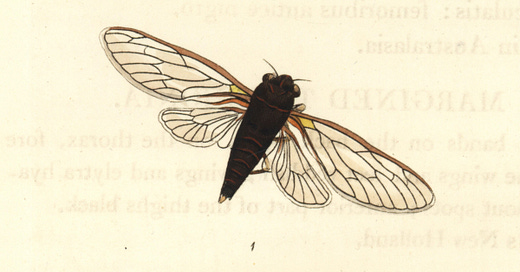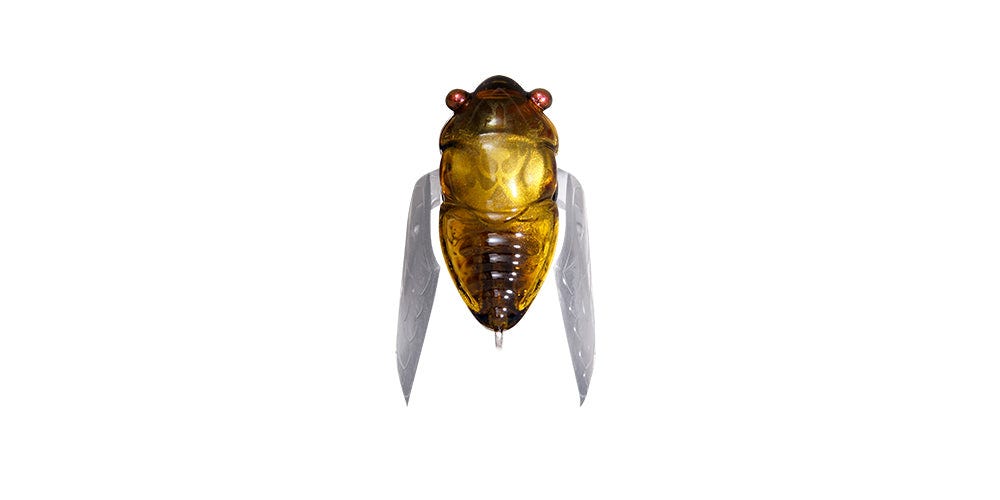Want to Catch More Summer Smallmouth? The Cicada/Bug Craze
Can this Newer Niche Rival Crayfish or Hellgrammite Baits?
The summer sun is beating down on most river systems throughout the region and many systems are very shallow given the lack of rain fall this summer. This creates many challenges for Smallmouth anglers especially those fishing from a kayak or wade fishing.
One of things many anglers are noticing is the last few weeks in our rivers are Cicadas. The question always becomes just which Cicadas these actually are given we often see these but there are also periodic specific Cicadas that release.
"You can go out and look for dime size holes, stick your pinky in them underneath oak trees. hardwood trees, maple trees. If you see these holes underneath those trees, it's a very good sign. You're going to have periodical cicadas," said Michael Raupp (University of Maryland)
For the first time since 1803 reportedly two periodic broods of Cicadas in 2024 will emerge together.
If you have heard the “song” of the Cicadas you will likely never forget it especially when Cicadas are located in mass along a river. 2021 was probably the most significant season for Cicadas in terms of density that most have experienced especially in the Mid Atlantic region but Cicadas are with us annually but the periodic “Broods” compound the volume in certain years.
🐟What are Cicadas and their life cycle?
✨How will Cicadas influence Smallmouth behaviors during summer ?
🎣What baits are out there to tap into the Cicada bite on our river systems?
Cicadas once again have been observed in parts of the region. There probably isn’t a potential forage for Smallmouth so misunderstood than Cicadas. They create quite the conversation at the boat ramp and online because it is one of the natural phenoms that some just don’t get to see much. In fact, when it comes to fly fishing anglers Cicadas will draw anglers from thousands of miles away to the rivers that are experiencing the arrival of Cicadas.
2024 Cicada Emergence?
In 2024, parts of North America like our region here in the Mid-Atlantic has witnessed the emergence of “periodic cicadas”, which are known for their synchronized, mass emergences after long intervals or what can only be described as dormancy. Most anglers recognize this when it comes to Crayfish though they don’t really ever truly go “dormant” as many believe but they do remove themselves from the river system by burrowing through late Fall to Spring but when it comes to Cicadas most are utterly confused by their cycles and random like arrivals.
Cicadas, particularly the periodic species such as Brood XIX and Brood XIII, showcase one of nature’s most intriguing life cycles. These broods, with their 13-year and 17-year cycles, respectively, spend most of their lives underground before emerging en masse, creating a spectacular and ecologically important phenomenon. Understanding their life cycles and emergence patterns helps us appreciate the complex dynamics of these fascinating insects and their role in our ecosystems
There are three species groups of periodic cicadas: 13-year and 17-year cicadas.
2024 Brood: Brood XIII (Northern Illinois Brood)
Brood XIII is a 17-year cicada brood emerging now in 2024.
This brood is claimed to be primarily found in northern Illinois, including the Chicago metropolitan area but may have a broader area.
Emergence typically begins in late May to early June, depending on soil temperatures, which need to reach around 64°F (18°C) at a depth of about 8 inches for nymphs to start emerging. This year appears to have come a few weeks later than norm.
Brood XIX: The Great Southern Brood
Cycle: 13 years
Next Emergence: 2024
Distribution: Southeastern United States, including states such as Alabama, Arkansas, Georgia, Illinois, Indiana, Kentucky, Louisiana, Missouri, Mississippi, North Carolina, Oklahoma, South Carolina, and Tennessee but also as far up the coast as Maryland.
The numbers expected this summer thus far have not been met given what whats anticipated from the XIX but when you come across them they are certainly hard to miss.
Stages of Development
Egg Stage:
Female cicadas lay their eggs in tree branches.
The eggs hatch in 6-10 weeks, and the nymphs drop to the ground and burrow into the soil.
Nymph Stage:
Nymphs live underground for 13 years, feeding on sap from tree roots.
They go through several developmental stages (instars) during this period.
Emergence and Molting:
In the 13th year, nymphs tunnel to the surface and emerge, usually in late April to early June.
They climb onto vegetation and molt one final time, transforming into winged adults.
Adult Stage:
Adults live for a few weeks to a couple of months.
Males sing to attract females, and after mating, females lay eggs in tree branches, starting the cycle anew.
General Cicada Distribution and Timetable
Cicadas are found throughout various regions of North America, with different species having varying ranges and emergence schedules.
Annual (Dog-Day) Cicadas
Distribution: Found throughout the United States and southern Canada.
Emergence: Annually during the summer months, usually from late June through August. We typically see these on river systems like the Shenandoah in the valley annually for example.
Species: Examples include the genus Tibicen (now Neotibicen).
Periodic Cicadas
Distribution: Primarily in the eastern United States.
Emergence: Occurs in 13-year and 17-year cycles, depending on the brood.
Broods: Different broods emerge in different years and locations. For example, Brood XIII in northern Illinois (2024), Brood X in the Mid-Atlantic and Midwest (last emerged in 2021)
Baits mentioned here will be part of Top Baits Tackle and available in the monthly options as well as may be included in the subscription box!!
HOW can Smallie Chasers utilize different types of baits to get bit on river systems during Cicada events and what baits are out there?
There are quite a few hard bait as well as soft plastic variations of baits for anglers to consider when it comes to using the Cicada theme. The hard bait segment are typically floating baits to mimic the falling Cicadas from the trees to the water. On of the brands that offers almost a dozen or more Cicada patterns is Smith.
Effective usage of hard baits to attract strikes:
・ Basically, slow down retrieve by lowering the rod tip. A wobbling that shakes its head from side to side is delivered, leaving a trailing ripple on the surface of the water.
・ Repeat taking poses by changing cadence of fine twitches several times. It delivers pop sounds and ripples on the surface of the water with a short movement distance, and appeals the existence of a cicada (main body) that falls and flutters. Often let simply sit still longer than you would any other topwater bait or popper.
-In addition, there are many cases where a bite is triggered by the “hot-hot method” that pauses for a long time when landing after casting.
-Connect the line directly to the split ring attached to the line eye with a union knot or clinch knot. (Smith)
Megabass is extremely popular and probably the most well known Japanese bait maker in North America offers baits in this niche as well. Its Tiny Siglett is a popular Cicada style hard bait if you can locate it is worth checking out. Coming in at just over two centimeters it truly is a finesse-like style presentation.
Duo Realis also makes a Cicada style bait that is becoming one of the most popular on the market. Its called Duo Realis Shinmushi Cicada Bug:
Coming in less than 2cm this one is truly bite size snack for Smallmouth. The “Duo Realis Shinmushi Cicada Bug features a detachable back, which enables anglers to adjust or replace the skirting material for a customized look. Highly detailed from end-to-end, the Duo Realis Shinmushi Cicada Bug is covered with a premium finish, molded accents, realistic eyes, and a feathered treble for added attraction. Offered in a number of rod-bending colors, the Duo Realis Shinmushi Cicada Bug delivers an abundance of action in a bite-sized package.”
Because of the stages of growth for the Cicada species, anglers can also use their Helgrammite style baits (SEE PREVIOUS POST IN NEWSLETTER) rigged with light line presented simply flipping into areas where the Cicada are located only not letting the bait fall to bottom. Simply work it like you have probably seen fly anglers work flies on the top of water. Anglers can place a very small nail weight for added casting but most be sure not to let the bait fall too much before retrieving and re casting when presenting this.
Here is a perfect option if you want to purchase specific soft plastics to throw: Imakatsu Mihara Mushi comes in five or so color options.
Want to learn more about Cicadas?
https://www.youtube.com/live/LRXm3WrXhPA?si=nSKyh0AZ48I9W-Nj
<iframe width="560" height="315" src="
title="YouTube video player" frameborder="0" allow="accelerometer; autoplay; clipboard-write; encrypted-media; gyroscope; picture-in-picture; web-share" referrerpolicy="strict-origin-when-cross-origin" allowfullscreen></iframe>
⭐⭐
If you enjoyed this please consider being a FREE SUBSCRIBER and JOINING THE CHASE as we learn to understand SMALLMOUTH more on this journey!
Subscribe TODAY for FREE and then this late summer JOIN the Premium Newsletter which will not only provide more in depth analysis but also locations for quality Smallmouth fishing and how to target them with the right bait presentations while also DELIVERING (1) BAIT per month to SUBSCRIBERS right to their door to fish with on their next river trip!!
Resources:
Facebook Groups:
Smallmouth Army:
https://www.facebook.com/groups/1322144201945490
Smallie Chaser River Bassin:
https://www.facebook.com/groups/885248796934955many challenges for Smallmouth anglers especially those fishing from a kayak or wade fishing.












